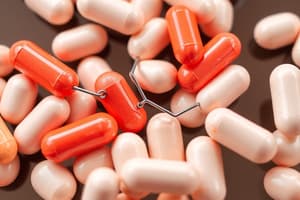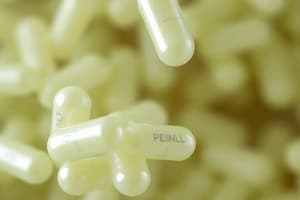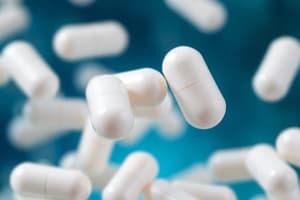Podcast
Questions and Answers
Why are beta-lactamase inhibitors often administered alongside beta-lactam antimicrobials?
Why are beta-lactamase inhibitors often administered alongside beta-lactam antimicrobials?
- To reduce the allergic reactions associated with beta-lactams.
- To prevent antimicrobial resistance by protecting the beta-lactam ring from hydrolysis. (correct)
- To improve the oral absorption of beta-lactam antibiotics.
- To enhance the bactericidal effect of beta-lactams directly.
A veterinarian is treating a dog with a suspected gastrointestinal infection caused by anaerobic bacteria. Which antibiotic would be least appropriate to prescribe initially without further diagnostics?
A veterinarian is treating a dog with a suspected gastrointestinal infection caused by anaerobic bacteria. Which antibiotic would be least appropriate to prescribe initially without further diagnostics?
- Metronidazole
- Cefoxitin
- Clindamycin
- Amikacin (correct)
Which statement correctly describes the mechanism of action of fluoroquinolones?
Which statement correctly describes the mechanism of action of fluoroquinolones?
- They inhibit folic acid synthesis, preventing DNA formation.
- They inhibit cell wall synthesis, leading to bacterial cell lysis.
- They interfere with bacterial DNA replication by inhibiting DNA gyrase and topoisomerase. (correct)
- They disrupt bacterial protein synthesis by binding to the 30S ribosomal subunit.
Why should tetracyclines be administered with caution, particularly regarding the consumption of milk or antacids?
Why should tetracyclines be administered with caution, particularly regarding the consumption of milk or antacids?
Which of the following is a major concern when administering chloramphenicol, especially in food-producing animals?
Which of the following is a major concern when administering chloramphenicol, especially in food-producing animals?
A veterinary ophthalmologist is considering topical antivirals for treating feline herpesvirus keratitis. Which of the following antivirals would be LEAST suitable due to its potential for causing severe irritation in cats?
A veterinary ophthalmologist is considering topical antivirals for treating feline herpesvirus keratitis. Which of the following antivirals would be LEAST suitable due to its potential for causing severe irritation in cats?
What is the primary mechanism of action of polyene antifungals like amphotericin B?
What is the primary mechanism of action of polyene antifungals like amphotericin B?
A dairy farmer is treating a herd for coccidiosis and wants to use a medication that is added directly to the feed. Which of the following anticoccidial drugs is most appropriate for this use?
A dairy farmer is treating a herd for coccidiosis and wants to use a medication that is added directly to the feed. Which of the following anticoccidial drugs is most appropriate for this use?
Ionophore antibiotics, such as lasalocid and monensin, are used as coccidiostats in poultry. What is their primary mechanism of action?
Ionophore antibiotics, such as lasalocid and monensin, are used as coccidiostats in poultry. What is their primary mechanism of action?
Several horses at a boarding stable have been diagnosed with Babesia. Which medication is most appropriate for treating Babesia in horses?
Several horses at a boarding stable have been diagnosed with Babesia. Which medication is most appropriate for treating Babesia in horses?
What is a major consideration for a veterinarian choosing between pyrethrins and pyrethroids for flea control in a household with cats?
What is a major consideration for a veterinarian choosing between pyrethrins and pyrethroids for flea control in a household with cats?
Organophosphates and carbamates are classes of antiparasitic drugs with a specific mechanism of action. What is this mechanism?
Organophosphates and carbamates are classes of antiparasitic drugs with a specific mechanism of action. What is this mechanism?
What is the primary mechanism of action of macrolides (macrocyclic lactones) such as ivermectin and selamectin as antihelminthics?
What is the primary mechanism of action of macrolides (macrocyclic lactones) such as ivermectin and selamectin as antihelminthics?
Certain dog breeds are predisposed to ivermectin toxicity due to a specific genetic mutation. What is the mechanism behind this increased sensitivity?
Certain dog breeds are predisposed to ivermectin toxicity due to a specific genetic mutation. What is the mechanism behind this increased sensitivity?
Why are benzimidazoles administered over multiple days?
Why are benzimidazoles administered over multiple days?
Which of the following statements accurately describes the mechanism of action of praziquantel against cestodes (tapeworms)?
Which of the following statements accurately describes the mechanism of action of praziquantel against cestodes (tapeworms)?
Which of the following regarding potentiated sulfonamides is correct?
Which of the following regarding potentiated sulfonamides is correct?
Which characteristic can be used to describe older penicillins?
Which characteristic can be used to describe older penicillins?
What is the mechanism of action for Aminoglycosides?
What is the mechanism of action for Aminoglycosides?
Which of the following is TRUE regarding lincosamides?
Which of the following is TRUE regarding lincosamides?
The following applies to third-generation cephalosporins EXCEPT:
The following applies to third-generation cephalosporins EXCEPT:
Which of the following is an example of a Beta-lactamase resistant antibiotic?
Which of the following is an example of a Beta-lactamase resistant antibiotic?
Why is it important not to use systemic antivirals close to vaccination periods?
Why is it important not to use systemic antivirals close to vaccination periods?
What makes newer generation fluroquinolones different from other antibiotics?
What makes newer generation fluroquinolones different from other antibiotics?
What is the mechanism of action of polymyxin B and E (colistin)?
What is the mechanism of action of polymyxin B and E (colistin)?
What is the main advantage of liposomal formulations for polyene antifungals like amphotericin B?
What is the main advantage of liposomal formulations for polyene antifungals like amphotericin B?
Why is the use of tetracyclines avoided for use in ruminants?
Why is the use of tetracyclines avoided for use in ruminants?
Why is it that potentiated sulfonamides are a good option for treatment?
Why is it that potentiated sulfonamides are a good option for treatment?
What is a potential result of administering aminoglycosides to a patient at normal concentrations?
What is a potential result of administering aminoglycosides to a patient at normal concentrations?
Which of the following best describes the spectrum of activity for Lincosamides?
Which of the following best describes the spectrum of activity for Lincosamides?
What is the mechanism of action of antiviral medication amantadine?
What is the mechanism of action of antiviral medication amantadine?
How do Imidazole & Triazole derivatives work to target fungi?
How do Imidazole & Triazole derivatives work to target fungi?
Which of the following can be assumed about administering oral anti-fungal medication alongside antacid medications?
Which of the following can be assumed about administering oral anti-fungal medication alongside antacid medications?
What is a clinical consideration for using amprolium for treatment of coccidia?
What is a clinical consideration for using amprolium for treatment of coccidia?
Certain dogs have a mutation related to to macrocyclic lactones. How does this affect drug resistance?
Certain dogs have a mutation related to to macrocyclic lactones. How does this affect drug resistance?
Which of the following best describes the spectrum of activity for Benzimidazoles?
Which of the following best describes the spectrum of activity for Benzimidazoles?
How is the treatment approach for trematodes different from other worm parasites?
How is the treatment approach for trematodes different from other worm parasites?
Flashcards
Beta-lactams MOA
Beta-lactams MOA
Inhibits cell wall synthesis in bacteria.
Beta-lactamases
Beta-lactamases
Enzymes that inactivate beta-lactam antibiotics.
Sulfonamides MOA
Sulfonamides MOA
Block folic acid synthesis which prevents DNA formation.
Quinolones MOA
Quinolones MOA
Signup and view all the flashcards
Aminoglycosides MOA
Aminoglycosides MOA
Signup and view all the flashcards
Tetracyclines MOA
Tetracyclines MOA
Signup and view all the flashcards
Phenicols MOA
Phenicols MOA
Signup and view all the flashcards
Macrolides MOA
Macrolides MOA
Signup and view all the flashcards
Polypeptides MOA
Polypeptides MOA
Signup and view all the flashcards
Lincosamides MOA
Lincosamides MOA
Signup and view all the flashcards
Idoxuridine MOA
Idoxuridine MOA
Signup and view all the flashcards
Polyenes MOA
Polyenes MOA
Signup and view all the flashcards
Azoles MOA
Azoles MOA
Signup and view all the flashcards
Allylamines MOA
Allylamines MOA
Signup and view all the flashcards
Amprolium MOA
Amprolium MOA
Signup and view all the flashcards
Lasalocid, Monensin MOA
Lasalocid, Monensin MOA
Signup and view all the flashcards
Imidocarb MOA
Imidocarb MOA
Signup and view all the flashcards
Meglutamine Antimoniate MOA
Meglutamine Antimoniate MOA
Signup and view all the flashcards
Pyrethrins, Pyrethroids MOA
Pyrethrins, Pyrethroids MOA
Signup and view all the flashcards
Organophosphates & Carbamates MOA
Organophosphates & Carbamates MOA
Signup and view all the flashcards
Amitraz MOA
Amitraz MOA
Signup and view all the flashcards
Avermectins MOA
Avermectins MOA
Signup and view all the flashcards
Benzimidazoles MOA
Benzimidazoles MOA
Signup and view all the flashcards
Tetrahydropyrimidines MOA
Tetrahydropyrimidines MOA
Signup and view all the flashcards
Imidazothiazole MOA
Imidazothiazole MOA
Signup and view all the flashcards
Piperazine MOA
Piperazine MOA
Signup and view all the flashcards
Isoquinolones MOA
Isoquinolones MOA
Signup and view all the flashcards
Salicylanilide MOA
Salicylanilide MOA
Signup and view all the flashcards
Study Notes
- Beta-lactams, cephalosporins, carbapenems, and monobactams are types of antibiotics.
Beta - Lactams
- Penicillins are a subgroup that inhibit cell wall synthesis to kill bacteria.
- Older penicillins have a narrow spectrum, with Penicillin G & V as key examples.
- Aminopenicillins like Ampicillin and Amoxicillin target penicillin-binding proteins and have a broad spectrum of activity.
- Beta-lactamase-resistant antibiotics, such as Cloxacillin, are designed to overcome bacterial resistance.
- Some are poorly absorbed orally and are broken down by HCL, like Penicillin G, others like Penicillin V, Ampicillin, and Amoxicillin are well absorbed orally.
- Allergic reactions, GI and Blood disorders are adverse reactions.
- Bacteria produce beta-lactamases, decrease cell membrane penetration, resist the target, and use efflux pumps, all as mechanisms of resistance.
- Used for respiratory and GI infections, UTIs, soft tissue infections, mastitis, and endocarditis.
- Beta-lactamases are enzymes that deactivate the drug by hydrolyzing the beta-lactam ring.
- Beta-lactamase inhibitors like clavulanate and sulbactam are co-administered with beta-lactam antimicrobials to combat resistance.
Cephalosporins
- First-generation cephalosporins (Cephalexin, Cephadroxil, Cephapirin, Cefazolin) inhibit cell wall synthesis and are bactericidal with a wider spectrum.
- Active against gram-positive bacteria
- But also some gram - negative bacteria
- Unstable in gastric acid and need to be administered parenterally
- First and Second generation drugs are well absorbed orally
- They are distributed well in fluids and tissues, except for the cerebrospinal fluid (CSF).
Sulfonamides
- Sulfonamides and potentiated sulfonamides block folic acid synthesis, preventing DNA formation, and mainly administered orally
- Have a broad spectrum of activity, effective against Gram-positive and Gram-negative bacteria, as well as protozoa, and are widely distributed in tissues and fluids.
- Crystaluria (renal obstruction), keratoconjunctivitis sicca (in dogs), hepatic necrosis, blood clotting, and GI tract reactions are adverse side effects
- Overproduction of PABA, efflux pumps, decreased permeability, and changes in target enzyme are mechanisms of resistance for bacteria
- Used for UTIs, respiratory and GI infections, and skin and soft tissue infections.
- Potentiated Sulfonamides are combined with to treat coccidiosis and toxoplasmosis, frequently prescribed for dogs and cats.
- Teratogenic effects and transferable resistance are other considerations.
Quinolones
- Quinolones and Fluoroquinolones inhibit DNA replication
- First-generation quinolones like Nalidixic Acid target DNA gyrase, while second-generation drugs (Difloxacin, Enrofloxacin) also inhibit topoisomerase.
- They exhibit a narrow to broad spectrum of activity and are bactericidal.
- They display good oral absorption, administered once or twice per day, and accumulate in inflammatory cells
- Tendinopathy and retinal degeneration in cats are adverse reactions.
- Decreased permeability, increased efflux, altered target enzymes, and mutations are bacterial resistance mechanisms.
- Used for respiratory, UTIs, and GI infections, and resistance is maintained even after stopping treatment.
Aminoglycosides
- Aminoglycosides (Kanamycin, Neomycin, Gentamycin, Amikacin) inhibit bacterial protein synthesis by binding to 30S ribosomes and are bactericidal
- Active against Gram-negative aerobes
- Useful with Beta-lactams which can act synergistically on Gram-positive pathogens
- Aminoglycosides are not absorbed from the GI tract and are highly polar; only used IM or SC for systemic infections or oral for GI disorders
- Have affinity for renal and otic tissue, cause autotoxicity and nephrotoxicity (why NMB blocking agents are needed) + Allergic reactions (but only at dermal level)
- Secrete enzymes to degrade the antibiotic, natural resistance in anaerobes
- Used for severe aerobic Gram-negative bacterial infections.
Tetracyclines
- Tetracyclines (Oxytetracycline, Chlortetracycline, Tetracycline, Doxycycline, Minocycline) inhibit bacterial protein synthesis by binding to 30S ribosomes reversibly and are bacteriostatic
- Have a broad spectrum against Gram-positive and Gram-negative bacteria, aerobes, anaerobes, atypical, and intracellular bacteria, as well as protozoa.
- Impaired absorption (avoid salts, milk, antacids 3 hours before and atfer)
- Chelates calcium which can impair the healing process
- Superinfections and hepatotoxicity
- Binds important cations
- Efflux pumps, decreased cell permeability, and target alteration are resistance mechanisms
- Used for respiratory infections, tick-borne diseases, GI infections, UTIs, skin and reproductive infections, and ocular infections.
Phenicols
- Phenicols (Chloramphenicol, Florphenicol) inhibit bacterial protein synthesis by binding to 50S ribosomes reversibly and Can NOT be used in food producing animals
- Are broad in spectrum, but can act on eurokayotic ribosomes
- Cause: Bone marrow suppression, GI issues, and neurological effects
- Restricted in food producing animals as it causes Aplastic Anemia
- Should not be used close to vaccination periods as they are immunosuppressive
- Bacteria causes Cross resistance to Macrolides as they inhibit same site of action
- Used to treat severe Aerobic bacteria and MRSA's (resistant strands of the staphylococcus bacteria) in the: respiratory system, in the CNS & eyes including Salmonellas
Macrolides
- (Erythromycin, Oleandomycin, Troleandomycin, Azithromycin, Gamithromycin, Spiramycin, Josamycin, Tylosin, and Tilmicosin)
- According to the Macrolide rings they
- Inhibit bacterial protein synthesis, and are bacteriostatic or bactericidal in high concentrations
- Are absorbed orally, but are sensitive to stomach acid
- Highly Cardiotoxic
- High Accumilation in the microphages
- Efflux-pumps action
- Alteration of subunits
- Used where patient is allergic to penicillins (Second choice for the bacterial infections)
- Good for: Respiratory, Mastitis, Enteritis, pyrometra, & conjunctivitis
Polypeptides
- Polymyxin B, Polymyxin E are Polypeptides
- Alter the cell membrane
- Can result in bacterial lysis
- High integrity for gram NEGATIVE cell membrane
- Use both topically or as last resort for resistant strands of Gram negotive bacteria.
- Can cause reactions at application site/ infections and may be nephortoxic and neurotoxic
- For Topicall applications: Ear infections, Skin infections & eye infections
Lincosamides
- Lincomycin, Clindamycin
- Inhibits synthesis by linking into bacterial cell
- Both good to use against broad infections
- Both cause disturbance and have cross resistance
- Diffuse across Placent
- Good alternative to Pennicillan ( used to treat general infections, dental areas etc...)
Studying That Suits You
Use AI to generate personalized quizzes and flashcards to suit your learning preferences.




